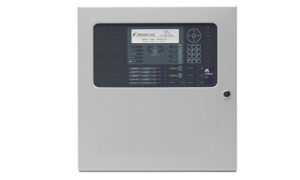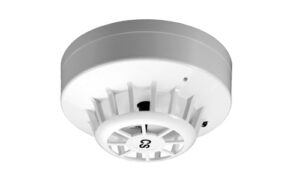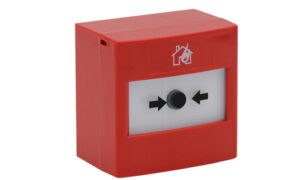Components of a Fire Detection and Alarm System – 19th July 2021
Components of a Fire Detection and Alarm System
There are a variety of components that form a fire alarm system – the requirements of fire alarm system are subject to the Regulatory Reform (Fire Safety) Order 2005 and the design and installation of fire alarm systems is subject to British Standard BS 5839-1:2017.
Control Panels

Control panels continuously manage and monitor the fire alarm device circuits and provide power to these circuits. They provide indication of fire alerts, faults and location. Control panels enable the configuration, testing, disablement and triggering of fire alarm signals and devices. Control Panels are usually located in a low fire risk area such as an entrance / exit lobby and should be accompanied by a zone chart.
Smoke Detectors

Ionization Smoke Detectors
Ionization chamber smoke detectors detect smoke by the reduction it causes in the current that flows between electrodes in an ionization chamber within the detector.
Optical Smoke Detectors
Optical smoke detectors detect smoke by means of the light scatter that results from the presence of a small light source within the detector.
Optical Smoke Beam Detectors
Optical beam detectors operate by detecting the obscuration of the light source that occurs in the presence of smoke.
Combustion Gas Detectors
Combustion gas detectors are point-type detectors that respond to one (or more) of the gases produced by a fire. For example, carbon monoxide is produced when incomplete combustion occurs as a result of restriction of the amount of oxygen available to support the combustion process.
Flame Detectors
Flame detectors detect the infrared and/or ultraviolet radiation that is emitted by flame. Both types use radiation-sensitive cells that “see” the fire either directly or through built-in lenses or reflectors.
Heat Detectors
Heat detectors may take the form of either point type detectors or line type detectors. The detection system may be designed to respond when a fixed temperature is reached. The heat detector may also include a sensor that responds to the rate of rise of temperature. In this case, the detector responds when either the temperature rises at more than a certain rate, or when the fixed temperature is reached.
Multi Sensor Detectors
In a fire detection and alarm system incorporating multi-sensor detectors, each multi-sensor fire detector contains more than one sensor, each of which responds to a different physical and/or chemical characteristic of fire. For example, with a heat and optical multi-sensor detector the optical sensor might be disabled during the day. If this is the case, it is vital that the detectors are spaced for the least sensitive sensor, in this case, heat.
Manual Call Points

Manual call points or Break Glass call points are a key component of a fire detection and fire alarm system which is used for the manual initiation of an alarm. Manual call points should be sited where they can be easily seen next to premises exit doors but not where they are likely to be exposed to accidental damage. It is recommended that they should be fitted with protective covers to reduce the likelihood of a false activation.
Alarm Sounders

Fire alarm sounders are an audible fire alarm device such as a Bell, Dome Bell, Sirens Solid Sate Sounder and Horn and operate throughout the building to indicate the need for evacuation of the entire building. Traditionally, a sound pressure level of 65 dB(A) has been regarded as the minimum acceptable sound pressure level for fire alarm signals or 75 dB(A) in sleeping accommodation. Also the fire alarm sound level should be a further 10 dB(A) above any ambient noises that may be present in a premises.
Power Supply The power supply for the fire detection and fire alarm system is normally derived from the low voltage mains supply in the building. The mains supply needs to be reliable and capable of supplying the largest load that can be placed on it under normal, fire and fault conditions. The mains supply needs to be backed up by a standby supply that is able to support the system while the fault in the mains supply is corrected.
Regular Testing
It is vital that a regular weekly and monthly test to be carried out to ensure that there has not been any major failure of the entire system, or a significant part of the system. For full guidelines please refer to BS 5839-1:2017 Fire detection and fire alarm systems for buildings. Code of practice for design, installation, commissioning and maintenance of systems in non-domestic premises
Weekly tests:
– A manual call point should be operated during working hours (as the purpose of the test is to familiarise and ensure the occupants of a premises can hear the alarm), at approximately the same time each week.
– A different manual call point should be used each time.
– Voice alarm systems should be tested in accordance with BS5839 Part 8Fire detection and fire alarm systems for buildings. Code of practice for the design, installation, commissioning and maintenance of voice alarm systems
Monthly tests:
– Any automatically started generator used for the fire detection and fire alarm system should be tested
– Any vented batteries used as a standby power supply for the fire detection and fire alarm system inspected
Inspection and Servicing
Fire alarm systems need to be inspected and serviced every Six Months by a competent person. Due to the specialist nature of the work, fire alarm inspections are usually contracted out to a fire alarm service organization such as RES, whose competence can be assured via third-party certification and accreditation.
RES are accredited to British Standard Institute BSI EN ISO 9000, are a BSI Kitemark Licenced Fire Alarm Installer, and have BAFE Accreditation for Fire Detection and Alarm System Modular Scheme SP203 – Part 1. RES are also members of The British Fire Consortium, Fire Industry Association, The Fire Protection Association.
;)
